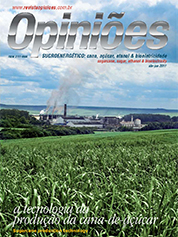Tadeu Luiz Colucci de Andrade
Research and Development Director at CTC
Op-AA-28
Reconquering the leading role
In this edition of Opiniões Magazine, we have specialists of different areas showing the challenges overcome and still to overcome in the industry that we today refer to as the sugarcane-based sector. Among the main challenges to overcome are: expansion of cultivated areas, more adequate genetic materials for new planting areas, new products that may be obtained from sugarcane, more sustainable, environment friendly social and economic exploitation, logistics of cutting, loading and transporting, training of specialized professionals, etc.
Each of them will require new technological processes, and some will place us on the frontier of the knowledge already acquired in the long period in which this crop has been commercially exploited.
Expansion of this crop to the new agricultural frontier occurred by using the varieties developed for the old production areas. This means that not necessarily will production be achieved at current levels, because this genetic material is not specific for the new production environments.
The supply of adequate materials will only occur in future as the result of regional selections that only now are taking place. In traditional areas, the adoption of already developed but not applied technologies may immediately boost productivity.
As incredible as this may seem, it shows that the production sector still does not make adequate use of the available technological potential, so one can well imagine the challenges it will face with the coming about of the imminent technological revolution.
In this same scenario we also find ethanol production using sugarcane biomass as raw material. At the beginning of the utilization of this technology, one only considered using bagasse, because it already was in the industry as a by-product of first generation production of sugar and ethanol. With the introduction of green sugarcane harvesting, a new raw material, straw, became available.
If bagasse was already in the industry, straw became an alien element in terms of its utilization. We lacked the machinery to collect and transport it. Its industrial processing was an unknown and even today is still a major challenge.
Environmental issues placed agricultural practices, which, until then, had been the reason for the crop’s success, under heavy criticism. Labor practices no longer met current demands. New pests and diseases still challenge our scientists in the quest for efficient and sustainable alternatives.
Cutting, loading and transporting, both of sugarcane and straw, challenge researchers to seek the optimization and development of new equipment. For sugarcane we have already set the maximum economically feasible distance for its use, specified cutting and loading equipment with good supply levels in the market. For straw we are still in early study phases, which are expected to set the economic parameters for its utilization.
Still with respect to straw, we will also have to determine how much will be technically appropriate to extract from planted areas and how to solve the problem of the huge volume of earth transported to the mill. Transportation is also the hostage of the road transportation modality, which is increasingly being questioned, particularly its use in the vicinity of urban centers. The search for new modalities is stuck in the research stage.
With respect to the availability of technicians specialized in agricultural and industrial processes, a crisis already occurred during the crop’s previous growth wave and now, if we consider the future supply demand the market will face, it becomes clear that a new expansion wave will come about and there will not be adequate supply of professionals.
In industrial processing, water consumption, gas emissions and the destination of by-products started to be questioned, and are in the full process of being improved.
No doubt solutions for these challenges will be found, but they place us in a problem situation – if we put all efforts into looking for totally innovative solutions, such as, for example, the production of second generation ethanol, we run the risk that after the hydrolysis of biomass, we will direct the fermentation process towards the same technology that produces first generation ethanol, and this technology will have been neglected in terms of updated research.
Another risk we face is of fragmenting research into several areas, both basic research and applied research. If these areas are not efficiently coordinated and transparent, they may consume huge amounts of resources and result in agricultural and industrial processes that will not be applicable to sugarcane and, what is even worse, we will become our own competitors in the search for solutions.
Therefore, all parties involved in the sugarcane-based industry are called upon to bring about an effective coordinated initiative to be able to lead in exploiting the energy potential of this crop. Losing the leading position in the world in the production of ethanol is but the first signal of just how vital this coordination is.




